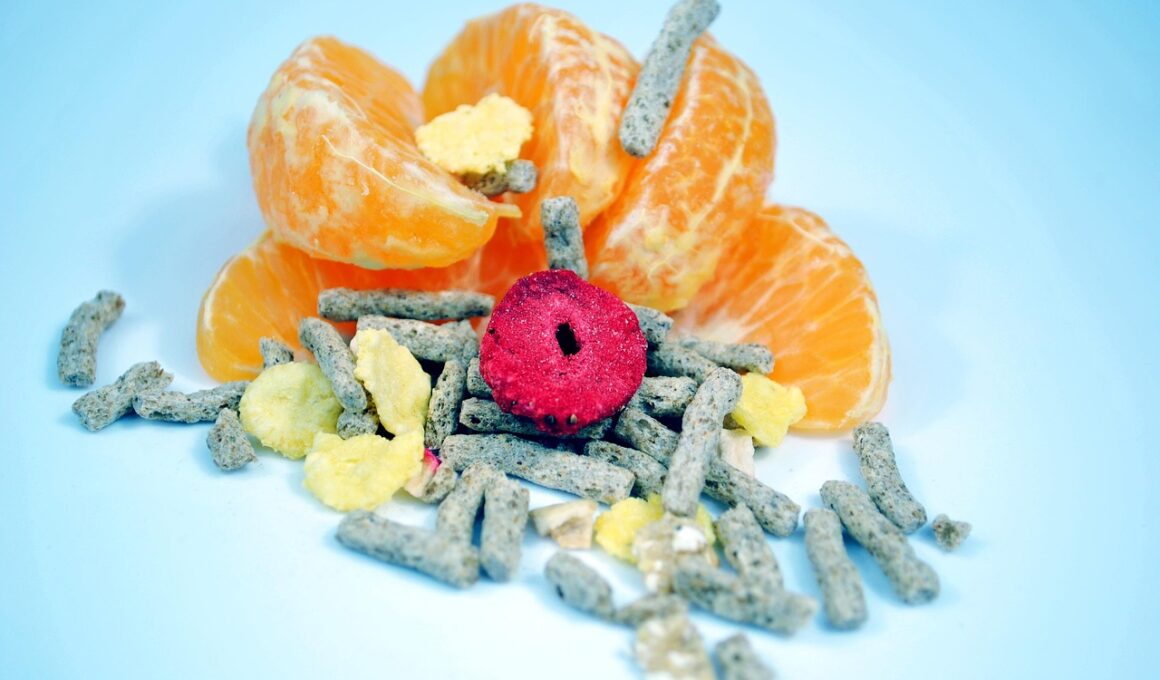How Fiber Helps Dogs With Digestive Disorders
When it comes to dog nutrition, fiber plays a crucial role in maintaining digestive health. Including adequate fiber in a dog’s diet can effectively address various digestive disorders such as diarrhea and constipation. Fiber acts as a bulking agent, which can absorb water and increase the bulkiness of the stool. It supports regular bowel movements by promoting intestinal motility. Incorporating both soluble and insoluble fibers can aid in overall digestion. Sources of soluble fiber include oats and peas, while insoluble fiber can be found in whole grains and leafy greens. High-quality dog foods often include specific fiber sources that cater to dogs suffering from digestive issues. Consult with a veterinarian to determine the appropriate amount of fiber for your dog’s specific needs. Adding these fibers can help balance the digestive tract by flushing out toxins and supporting the growth of beneficial gut bacteria. Ensuring your dog receives enough fiber can significantly improve their digestive health, leading to a more active and happier pet. This dietary adjustment will not only support daily wellness but also reduce the risk of long-term digestive problems.
Fiber is essential for regulating blood sugar levels and can be particularly beneficial for dogs prone to diabetes. Soluble fiber, which dissolves in water, slows the absorption of sugar, preventing spikes in blood glucose. This regulation allows for a more controlled release of energy, which is crucial for diabetic dogs. Moreover, fiber contributes to satiety and can help in weight management, mitigating obesity-related issues. By maintaining a healthy weight, your dog reduces the risk of developing further complications associated with diabetes. To effectively include fiber in your dog’s diet, consider incorporating vegetables like carrots and green beans, which are low in calories but high in essential nutrients. However, consult with your veterinarian before making significant dietary changes. Fiber also interacts positively with other nutrients, making it a key player in comprehensive nutrition. This interaction helps ensure that every bite your dog takes provides maximum nutritional benefit. Gradually increasing the fiber content in their diet will help avoid any sudden gastrointestinal distress. Consistency is key when introducing new foods, ensuring a smooth transition and better digestive outcomes.
Different Types of Fiber
Understanding the different types of fiber can help in choosing the best options for your dog’s diet. Generally, fiber is categorized into two main types: soluble and insoluble. Soluble fiber dissolves in water and forms a gel-like substance in the stomach, aiding in the control of blood sugar levels and managing diarrhea. On the other hand, insoluble fiber promotes regular bowel movements by adding bulk to the stool and speeding up transit time through the gastrointestinal tract. This type of fiber is essential for dogs that suffer from constipation, providing relief and improving stool consistency. Incorporating a mixture of these fibers helps create a balanced, healthy diet, as each type serves its own beneficial purpose. Read food labels carefully to ensure you’re choosing a dog food that includes a variety of fiber sources to meet your pet’s needs. Items like pumpkin and sweet potato are excellent choices as they contain both fiber types, ensuring your dog enjoys both digestive and nutritional benefits. Likewise, remember that gradual introduction of fiber, in conjunction with ample hydration, will optimize digestion.
Aside from its digestive benefits, fiber can also play a role in preventing certain health issues associated with aging dogs. As pets age, they may experience slower metabolic rates, which can lead to weight gain and related complications. Fiber can help your older dog feel full, promoting more gradual and healthy weight loss without starving them. Additionally, fiber-rich diets can help with managing cholesterol levels, leading to better heart health, which is crucial for senior dogs. Incorporating fiber can support not only their digestive system but also their overall well-being, heightening vitality. Keep an eye on food labels and look for those with higher fiber percentages. Aging dogs are particularly susceptible to constipation and other digestive problems, making fiber an indispensable part of their diet. Always monitor your dog’s reaction to increases in fiber intake, and adjust accordingly. Regular veterinary check-ups can help determine the best dietary approach for your older canine companion, ensuring they lead a long, healthy, and active life despite age-related challenges.
Potential Side Effects of Too Much Fiber
While fiber is an essential part of a dog’s diet, excessive amounts can lead to several digestive issues. Overloading your dog with fiber may result in bloating, gas, and diarrhea, ultimately harming their digestive system instead of helping it. It’s crucial to introduce fiber gradually to avoid shocking their system. Monitoring your dog’s reactions to dietary changes is vital in managing their digestive health effectively. Following the advice of your veterinarian concerning the right fiber content is essential for optimal health. If your dog exhibits signs of discomfort after being introduced to fiber-rich foods, reassessing their intake is crucial. Balancing fiber with other nutrients, such as proteins and fats, is necessary for a well-rounded diet. Ideally, fiber should be part of a comprehensive nutritional strategy that supports overall vitality. Paying close attention to your dog’s daily fiber intake helps prevent future complications. Moreover, introducing high-quality dog food formulated by experts will ensure that fiber is included at appropriate levels for optimal health and digestive benefits.
Moreover, hydration plays a critical role in fiber’s effectiveness in a dog’s diet. A fiber-rich diet requires increased water intake to function properly. Without adequate hydration, dogs may struggle with constipation despite a high-fiber diet, rendering it ineffective. Always ensure your dog has access to fresh, clean water, especially when increasing their fiber. Regularly monitoring their water consumption is essential, particularly when introducing new fiber sources. Keeping your dog well-hydrated promotes digestion as fiber absorbs water in the intestines, aiding in stool formation and passage. Remember, fiber works best as part of a well-balanced diet that includes sufficient moisture levels. Selecting the right dog food can alleviate many digestive concerns while also ensuring they stay hydrated. In cases of severe digestive problems, consider consulting a veterinarian on the best foods and strategies for hydration. Regular vet appointments provide a substantial overview of your dog’s health, ensuring they are on the right nutritional path. A holistic approach to diet combining fiber and hydration can support your dog’s long-term health, leading to a healthier digestive system.
The Importance of Monitoring Fiber Intake
Lastly, tracking your dog’s fiber intake is essential for understanding their overall health. Each dog is different, and their nutritional requirements will vary depending on size, age, and existing health issues. Keeping a close eye on how much fiber your dog consumes will help gauge their digestive health. Should issues arise, adjusting their fiber intake becomes much easier. Consider maintaining a food journal to track your dog’s meals, noting fiber sources and amounts. Utilize the insights gathered from this record to collaborate with your veterinarian, ensuring that your dog’s nutrition is tailored to their specific needs. Finding the right balance may take time, but it will be rewarding in terms of improved health and vitality. Combining your observations with professional advice can create a tailored diet that emphasizes wellness. Understanding your dog’s nutritional needs also encourages proactive health management and potentially uncovers any underlying concerns early. Taking a comprehensive approach to your dog’s diet, incorporating fiber and continuously monitoring their progress, will lead to lasting health benefits both now and in the future.
In conclusion, recognizing the importance of fiber in your dog’s diet will significantly enhance their quality of life. Including fiber from various sources aids digestion, reduces health risks, and supports overall well-being. These essential elements are crucial in ensuring your furry friend remains healthy and happy well into their golden years. Carefully balance moderate fiber intake with hydration and other nutrients for optimal health benefits in dogs. Collaborating with your veterinarian on dietary choices is key to making informed decisions about your dog’s food and health management. Your dog’s specific needs should be the guiding factor in developing their nutrition plan. With a properly balanced diet, you can prevent and alleviate potential digestive issues, allowing for better digestive health. Monitoring their fiber intake is critical to understanding how dietary changes affect their health over time. Ultimately, a strong foundation of dietary fiber not only supports digestive function but ensures a long and happy life for your beloved pet. By being proactive in their nutrition, you will lay the groundwork for longevity and vitality in your dog’s life.


